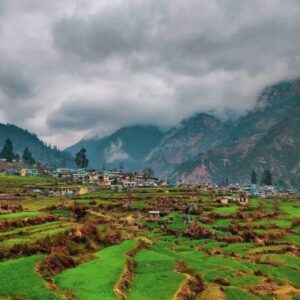Village Trips
Heritage Villages tour, One day hikes etc.
There is lots of villages in Joshimath region, which are known for there specific culture. Like Saloor-Dungra, Mana, Urgam, Niti, Malari etc. we offer one day tour and tour with homestay in these villages.

¶ 1 Days ♥ 15-100 Km ♣ Max 15
MAX ALTITUDE 2300 m
Call Directally at-
Brief Description
The villages and hamlets of Uttarakhand are located at some of the beautiful locations in the state; overlooking verdant hills, snow clad peaks and river streams. Rural tourism coupled with ecotourism is gaining acceptance in the region. Many villages in Uttarakhand have been turned into eco-friendly tourist destination for tourists to explore and relax amidst the lap of nature.
MANA Village

Hardly 3 km from Badrinath, Mana is the last village at the Uttarakhand Indo-Tibetan border. This quaint village is around 3219 m above sea level and boasts a clearer sky and cleaner air. Resting on the banks of River Saraswati, Mana is home to the Bhotias (Mongol tribe). One can spend an entire day here appreciating the exquisitely carved rustic cottages. Detox yourself in the calmness of Mana while enjoying the cascade at the Vasundhara Falls. Gaze and goggle at the origin of the Saraswati River. Watch her gracefully flow into the Alaknanda River to form the Keshav Prayag. Catch sight of the sturdy Bheem Pul. Gain some enriching experience at the annual fair of Mata Murti temple and sip on the warmth of tea at the last Indian tea stall. Mana is much more than a mythological experience. It is a boon for trek lovers. Basketful flora and picturesque canvas make Mana a trekker’s dream.

BEST TIME TO VISIT
Mana village is best to visit from May to early November. From November to April, the region remains inaccessible due to heavy snowfall.
URGAM Village
Located in the picturesque Urgam Valley near Joshimath in the Chamoli district of Uttarakhand, Urgam Village is a scenic hamlet tucked at an elevation of about 2100 mts Surrounded by snow-clad peaks of the Garhwal Himalayas and enveloped in dense forests, farmlands, and apple orchards, Urgam Village lies in Urgam Valley which is far away from the modern lifestyle and takes you to a world of its own.

The place is famous for the ancient Shiva temple, Kalpeshwar Temple, one of the revered Panch Kedars. Kalpeshwar Dham lies just 2 km ahead of Urgam Village.

SALOOR-DUNGRA Village
o visit Badrinath, one has to pass Joshimath. Joshimath recently shot into worldwide news because it was ‘sinking’. Not far from Joshimath is the scenic and much preferred skiing destination of Auli!
 But how many of us have heard of the twin villages of Saloor–Dungra, which are hardly half an hour away from Auli? And why should have one heard of Saloor-Dungra? Simply because, after the Baisakhi Festival, the village comes alive with one of the most colourful and musical festivals of Uttarakhand – called Ramman.
But how many of us have heard of the twin villages of Saloor–Dungra, which are hardly half an hour away from Auli? And why should have one heard of Saloor-Dungra? Simply because, after the Baisakhi Festival, the village comes alive with one of the most colourful and musical festivals of Uttarakhand – called Ramman.
What is the Ramman Festival?

As the name Ramman suggests, the festival is related to the Hindu epic, Ramayana. The stories of the epic are re-enacted with singing and masked dances by the villagers.
The guardian Deity of Saloor Dungra is ‘Bhumiyal Devta’. On the day of Baisakhi, the village priest announces the date for the Ramman Festival which falls on the ninth or the eleventh day after Baisakhi. The Bhumiyal Devta comes out in a procession to the temple on the day of Baisakhi. On the second day, people offer “hariyali” (sprouted barley plants) to the Deity who, in turn, promises prosperity to all, including agricultural yield and forest produce. Every day of the festival, the Devta takes a round of the village. The festival lasts for ten days during which time the local epic of Rama is sung and masked dances depicting different aspects of life take place in the courtyard of the Bhumiyal Devta’s temple.

The Ramman begins with an invocation to Lord Ganesh, the remover of obstacles, followed by the dance of Ganesh and Parvathi. This is followed by the dance of the Sun God, an enactment of the creation of the birth of Brahma and Ganesha. The other dances include the dance of the Bur Deva along with Gopi Chand (Krishna) and Radhika, the ‘Mwar-Mwarin’ dance that showcases the travails of the buffalo herders and the ‘Baniya-Baniyain Nritya’ (dance of the trader-couple) that shows the hardships faced by the common people.
After these initial performances, the focus shifts to the enactment of the local ‘Ram Katha’. The stories of the epic are re-enacted with singing and masked dances by the villagers. The unique feature of the festival is that all inhabitants reunite and perform their given roles without distinction of caste, creed, and status. Episodes from Rama’s life, beginning with his visit to Janakpur and culminating with his coronation following his return from exile, are sung to a total of 324 beats and steps. The performance has 18 participants, playing 18 characters wearing 18 masks and dancing to 18 beats to celebrate the 18 Puranas.
Another important aspect of these performances is the singing of ‘Jagar’, a musical rendition of local legends. There are also other dances and episodes that follow the Ram Katha. In the ‘Maal Nritya’, a historical battle between the Gurkhas of Nepal and the local Garhwalis is comically enacted by a troupe of four dancers dressed in red and white.
In the ‘Koorjogi’ ceremony, weeds (koor) from the village fields are pulled out by a Koorjogi, a character who carries a sack full of these weeds. There is much merriment as people throw these weeds at each other in a spirit of a communal sport.
After the festivities, the Deity stays at the home of one of the village families, which is decided by the village Panchayat. It stays there till the next season of the Ramman.
India is an incredible country. I have travelled extensively in the west, and I find their culture monotonous. Ours, on the other hand, is diverse and diversity requires more skill and strength to manage. Martin Luther King Jr had said that, when he travelled to other countries, he travelled to them as a tourist, but when he travelled to India, he travelled as a pilgrim! He was stating something that is so obvious!
NITI Village
Beyond these popular places, Niti Valley is a quaint hamlet that promises to offer an incomparable experience for travelers looking for serenity in the hills.

Niti is a remote valley located in the northernmost region of Garhwal Uttarakhand. Niti Pass was an ancient trade route between India and China, before it was sealed after the 1962 Sino-India war. Lata, Kaga, Dronagiri, Malari, Bampa, Gamshali are villages situated in the Niti Valley of the Chamoli District.

Nestled within the Nanda Devi Biosphere Reserve, Niti is the last village at the Indo-China border that tenders pristine beauty waiting to be explored. At a height of 3600mt above sea level, Niti village is approximately 85 km from Joshimath, the winter seat of Lord Badrinath.
MALARI Village
Malari village is situated in the extremely isolated corners of the Dhauli Ganga valley. This tiny village lies in the Nanda Devi Biosphere reserve near the Tibet border. A World Heritage site, this area is located 61 km from Joshimath, in Chamoli District of Uttarakhand.
Almost everyone has heard of the Valley of Flowers (and rightfully so), but no one is aware of the Valley of Perfumes located near to this village! The Valley of Perfumes is home to hundreds of species of flowers, all adding up to make for the most magnificent of aromas. The valley can be reached using two-wheelers and while your sense of sight has been gifted enough during this trip, your sense of smell will be delighted too! Must visit.
The Valley of Perfumes is home to hundreds of species of flowers, all adding up to make for the most magnificent of aromas. The valley can be reached using two-wheelers and while your sense of sight has been gifted enough during this trip, your sense of smell will be delighted too! Must visit.
- Food as per menu on the trek (Starting Lunch on Day 2)
- Forest Permits/Camping Charges , if any
- Tents, Sleeping bags, mats,Technical equipment
- Safety Equipments.
- Trek guide, cook, helpers, porters & mules for carrying common luggage.
- Services of a Trek Leader.
- 2 Nights Hotel stay in Joshimath.
- Meals during road journeys
- Meals during hotel stay
- Any expense of personal nature
- Any expense not specified in the inclusion list
- Transportation from Dehradun to Joshimath and back to Dehradun.





Our Most Demanding Treks

Kuari Pass Trek
This trek was explored by Lord Curzon and is also knows as the Curzon trail.
The trek passes through Pristine Rhododendron, oak, and deodar forest covered in layers of snow. For more seasoned trekkers, Kuari pass trek is the best way to rejuvenate.
From ₹5000 only

Valley Of Flower Trek
Indian government created the Valley of Flowers National Park in 1980. And it was recognized as a UNESCO World Heritage Site in 2002. This pushed Valley of Flowers on the bucket list of trekkers from around the world.
From ₹5000 only

Auli- Gorsion Bugyal Trek
Gurson Bugyal (Gorso Bugyal) is located at an altitude of 3056 mts, just 3 kms trek from Auli. It is a large land of green pastures surrounded by coniferous forest and oak trees.
The Auli Bugyal is a meadow (Bugyal means Meadow), which lay sprawling in the Chamoli District of Uttarakhand.
From ₹5000 only
Why Trek with us?
There are several companies and agencies, which will offer same services that we offer. Some of them are from Uttarakhand some are from outside Uttarakhand. But we from this region. From Joshimath, from Valley. We have lived our whole life in this part of Himalayas.
We are a team of certified and well trained professionals.
Happy clients
“Valley of Flower's trekking team is a group of well professionals. They organize our trek for Kuari Pass. And now i feel that we choose a well experience agency for this. Thankyou Valley of Flower.”
Rohit Sharma, New Delhi
“We did our trek to valley of Flower with these guys. They are always well prepared for all kind of emergencies. Good team."
Subhulakshmi, Chennai
"I visited Joshimath in the last weel of April. I joined a festival called RAMMAN in Saoor-Dungra village with valley of flower's team. That was amazing day. "
dr. Vikas Dwiwedi, Mumbai

